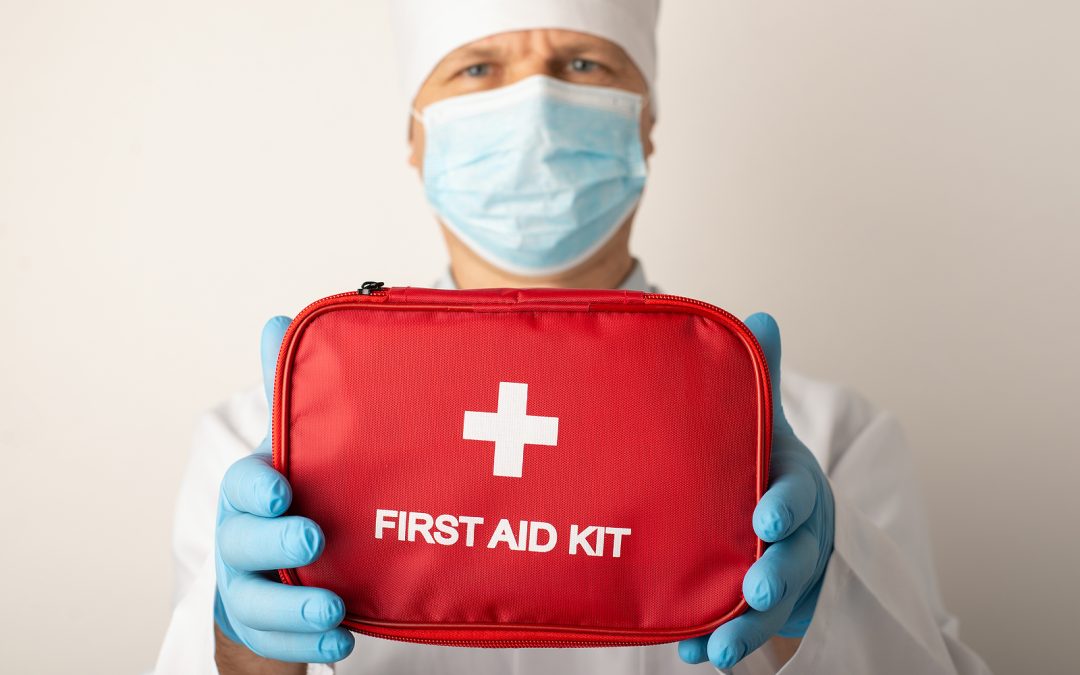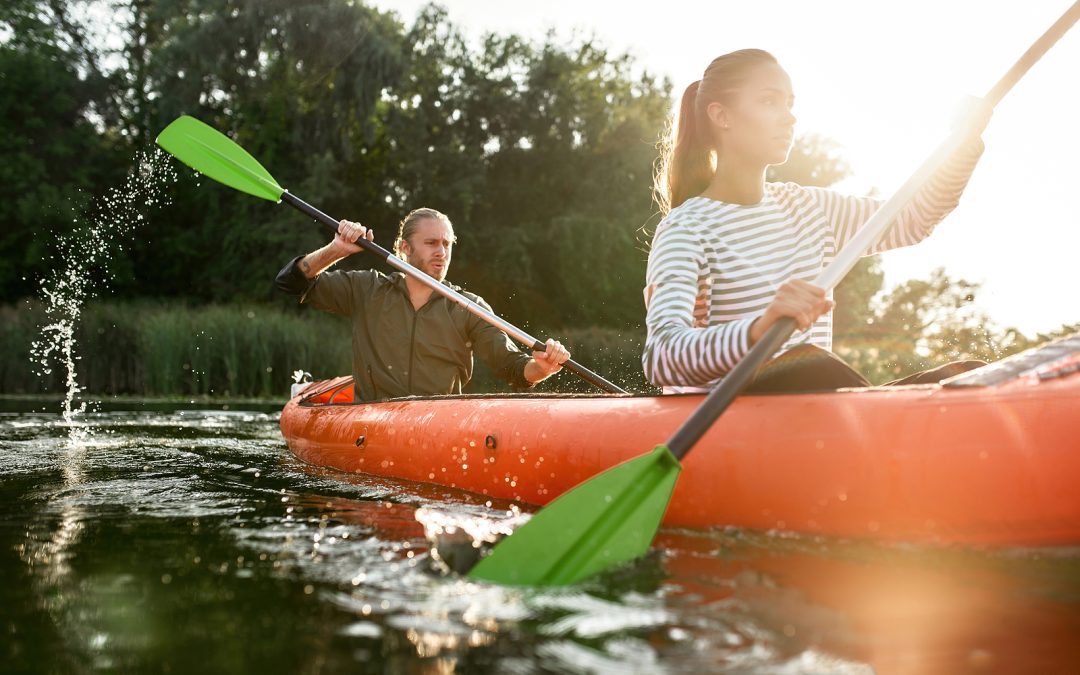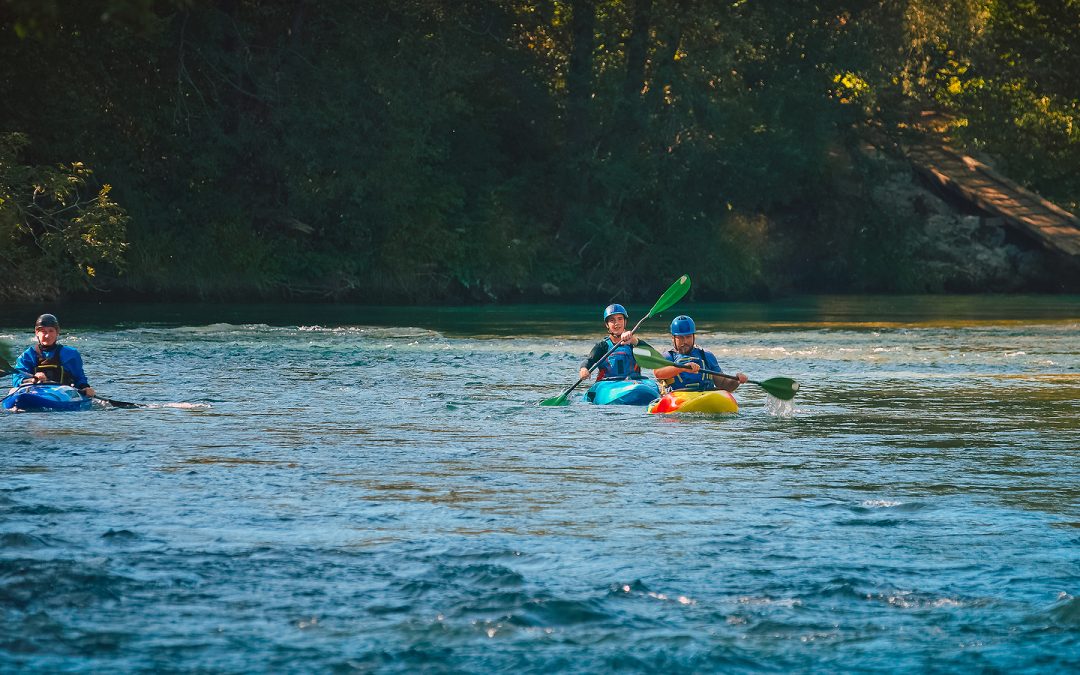Kayaking is a popular and versatile water sport that allows participants to experience nature and the outdoors in a unique way. As with any outdoor activity, safety is an essential component of ensuring an enjoyable experience. It’s important for both beginners and experienced kayakers to understand basic safety guidelines and best practices and always prioritize their safety and the safety of others.
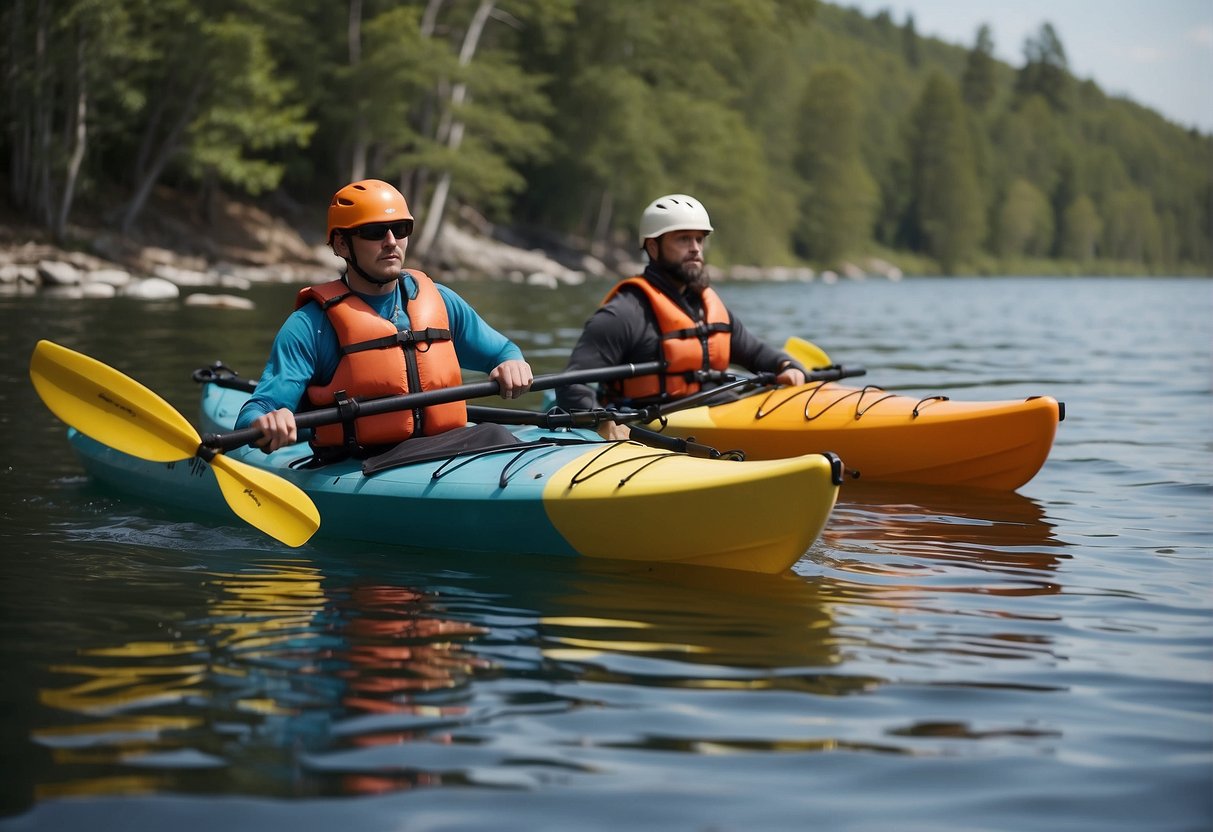
There are many aspects to consider when talking about kayaking safety. These range from choosing the right gear and understanding the basics of kayaking to being mindful of weather and water conditions. It is crucial that individuals equip themselves with knowledge and skills in order to be ready for unexpected situations that may arise while out on the water.
Key Takeaways
- Proper equipment and clothing contribute to overall safety in kayaking.
- Awareness of weather and water conditions is vital for a safe kayaking experience.
- Planning your trip and knowing how to handle emergencies is essential for kayaking safety.
Understanding the Basics of Kayaking
As a beginner in kayaking, it’s essential to have a solid understanding of the basics before venturing out on the water. This includes recognizing various types of kayaks and mastering some fundamental paddling techniques.
Kayak Types
There are several types of kayaks available, each designed for specific purposes or water conditions. Some of the most common types of kayaks are:
- Recreational kayaks: These are stable, easy to maneuver, and ideal for beginners. They are suitable for calm lakes and slow-moving rivers.
- Touring kayaks: Designed for longer trips on more open water, touring kayaks have better tracking and storage capacity for gear.
- Sit-on-top kayaks: Popular for warm environments, sit-on-top kayaks allow easy access and prevent being trapped inside in case of capsizing.
Be sure to choose a kayak that best suits your needs and the water conditions you plan to explore.
Paddling Techniques
Being proficient in basic paddling techniques is crucial to ensuring your safety and ability to navigate through various water conditions. Here are a few foundational techniques:
- Forward Stroke: This is the main stroke to propel your kayak. Insert the paddle blade fully into the water (near your toes), and using your torso rotation, pull the paddle through the water towards your hip.
- Sweep Stroke: A sweep stroke helps in turning the kayak. For a wide arc motion, fully extend your paddle while keeping the blade flat against the water and sweep it out to the side.
- Reverse Stroke: To stop or reverse the kayak, perform the forward stroke in reverse. Rotate your torso, place the paddle blade near your hip, and push the blade towards your toes.
Once you have a good understanding of these fundamentals, practice them in calm, shallow waters before venturing into more challenging environments. Remember that kayaking safely and effectively requires confidence, knowledge, and a clear understanding of your abilities and the water conditions you encounter.
Importance of Personal Flotation Devices
Personal Flotation Devices (PFDs) are a crucial safety measure for kayakers, canoers, and stand up paddle boarders. These devices provide buoyancy, assisting in keeping an individual afloat in the water. PFDs encompass life jackets, life vests, and other types of flotation aids, which prioritize the user’s safety during water-based activities. Wearing a PFD can significantly reduce the risk of drowning and improve a person’s chance of survival in case of accidents or emergencies1.
Types of PFDs
There are different types of PFDs designed to cater to specific needs and conditions. The most common types are:
- Type I PFDs: Offshore Life Jackets – These PFDs are suitable for open and rough water conditions where rescues can take more time. They can turn most unconscious wearers face-up in the water2.
- Type II PFDs: Near-Shore Buoyant Vests – These PFDs are appropriate for calmer waters, closer to the shore2.
- Type III PFDs: Flotation Aids – Designed for recreational activities such as kayaking or sailing, these PFDs allow for more freedom of movement2.
- Type IV PFDs: Throwable Devices – These are cushion-like flotation devices meant to be thrown to someone in distress, commonly used on boats2.
Correct Usage of PFDs
To ensure the effectiveness of a PFD, it is essential to wear it correctly. Follow these guidelines for correct PFD usage:
- Choose the right size: A PFD should fit comfortably and snugly according to the user’s body weight and chest size3.
- Check for proper buoyancy: The right PFD will keep the wearer’s head above water, even if they are unconscious1.
- Inspect regularly: Regularly check your PFD for signs of wear and tear, such as broken buckles, frayed straps, or punctures4.
- Wear it at all times: A PFD can only save your life if you wear it consistently during water activities1.
By understanding the different types of PFDs and their correct usage, kayakers and other water sports enthusiasts can significantly improve their safety while enjoying their favorite activities.
Footnotes
- https://www.outdoorplay.com/blogs/news/the-mighty-pfd-personal-flotation-safety-for-kayakers ↩ ↩2 ↩3
- https://kayakbeasts.com/personal-flotation-device-pfd/ ↩ ↩2 ↩3 ↩4
- https://www.rei.com/learn/expert-advice/personal-flotation-device.html ↩
- https://www.rei.com/learn/expert-advice/paddling-safety-rescue-gear.html ↩
Dressing for Safety
Assessing Weather Conditions
Before heading out for a kayaking adventure, it is crucial to check the weather conditions and the water temperature. Being aware of the weather can help you choose the appropriate clothing to wear while out on the water. Keep in mind that weather can change quickly, and it is always better to be prepared for unexpected changes in temperature, wind, or precipitation.
When planning your kayaking trip, keep an eye on the forecast, and be prepared to adjust your attire accordingly. Dressing for the water temperature, rather than just the air temperature, is essential to prevent hypothermia in case of an accidental capsize.
Choosing Appropriate Gear
Selecting the appropriate clothing is essential for safety and comfort during your kayaking excursion. Here is a list of recommended attire based on various temperature ranges:
- Cold water (Below 60°F/15°C): It is essential to wear a drysuit to protect yourself from the cold water. Drysuits have a waterproof outer layer and are designed to keep you dry and warm. Don’t forget to wear moisture-wicking base layers and warm insulating layers underneath.
- Cool water (60°F/15°C – 70°F/21°C): A wetsuit is a good option in this temperature range. Wetsuits use snug-fitting neoprene material to trap a thin layer of water between your body and the suit, which your body warms. This helps to retain body heat during the time spent kayaking.
- Warm water (Above 70°F/21°C): In warmer water, it is best to opt for lightweight, moisture-wicking layers, such as polyester or synthetic blends. These materials help keep you cool and move sweat away from your body. Don’t forget to wear a hat and apply plenty of sunblock to protect yourself from the sun.
In addition to the clothing mentioned above, always remember to wear a proper life jacket for added safety. Dressing appropriately for your kayaking adventure will not only ensure your comfort but also significantly influence your overall experience and safety.
Safety Equipment Essentials
Protective Gear
When kayaking, it’s crucial to wear appropriate protective gear to ensure a safe experience. A key piece of equipment is the helmet, particularly for whitewater and surf kayakers. Helmets should fit comfortably and securely fasten under the chin. It is also essential to wear a personal flotation device (PFD), which helps in keeping the kayaker buoyant in the water. A properly-fitting PFD should be snug but not restrictive.
Protective clothing, such as wetsuits or drysuits, is also necessary to keep paddlers warm in colder conditions. Additionally, don’t forget to pack a first aid kit that includes items such as bandages, antiseptic wipes, and medical tape. Store all your essentials in a dry bag to keep them safe from water damage.
Emergency Devices
In case of emergency situations, it’s vital to have devices that can alert others or help you navigate back to safety. A whistle is a simple yet effective tool for signalling distress. A loud whistle can alert nearby paddlers or rescue teams in case of an accident or injury.
A flashlight or other light-emitting devices are essential for visibility, especially in low-light conditions or when navigating at night. In addition to these devices, consider carrying a bilge pump to remove excess water from the kayak, which helps to stay afloat in case of any leaks.
For better communication in emergency situations, a VHF radio can be invaluable. It allows paddlers to communicate with nearby boaters or rescue teams in case of emergency.
| Safety Equipment | Purpose |
|---|---|
| Helmet | Head protection in whitewater kayaking |
| PFD | Buoyancy and flotation |
| First Aid Kit | Treating injuries |
| Whistle | Distress signal |
| Flashlight | Visibility in low-light conditions |
| Bilge Pump | Removing excess water from the kayak |
| Dry Bag | Waterproof storage for essentials |
| VHF Radio | Communication in emergencies |
Following these safety equipment essentials guidelines and being prepared for any unexpected situations will help ensure a safe and enjoyable kayaking experience.
Weather and Water Conditions Awareness
Checking Forecasts
Before embarking on a kayaking adventure, it is crucial to check the weather forecast. Be aware of the expected wind and waves conditions to ensure a safe and enjoyable experience. Keep an eye on the forecast not only for the day of your trip but also for the days leading up to it, as previous weather conditions might affect the water environment. Make sure to monitor local news and weather websites for updates on the predicted weather patterns.
If strong winds or large waves are predicted, it is advisable to postpone your kayaking expedition. On the other hand, if it is just a light shower, you may still proceed but pack appropriate gear, such as a raincoat and spare clothes.
Water Temperature Considerations
Another important aspect to consider is the water temperature. Cold water poses a risk for hypothermia, especially when combined with wet clothing and wind. To minimize this risk, make sure to wear proper attire that keeps you warm and dry. Layering is key – it allows you to adjust your clothing according to the temperature, especially during longer trips.
Here are some recommendations for kayaking gear depending on the water temperature:
| Water Temperature | Suggested Gear |
|---|---|
| 60°F (16°C) and above | * Wetsuit or drysuit * Paddle jacket |
| 50°F (10°C) – 60°F (16°C) | * Neoprene wetsuit (3mm minimum) * Paddle jacket or dry top |
| Below 50°F (10°C) | * Neoprene wetsuit (3mm-5mm thickness) * Drysuit with insulation layers * Paddle jacket or dry top |
Aside from wearing suitable clothing, be conscious of your boundaries: do not venture too far from the shore when the water temperature is low, and always inform someone about your planned route and expected return time.
Remember that the weather and water conditions play a significant role in determining the safety and enjoyment level of your kayaking experience. By staying aware of the forecast and water temperature, and making necessary adjustments, you can ensure a delightful and secure adventure.
Safe Kayaking Practices
Avoiding Alcohol and Substances
One of the essential aspects of safe kayaking is to avoid consuming alcohol or other substances that impair judgment and coordination. Alcohol is a significant factor in many boating accidents, as it can compromise a paddler’s ability to react quickly and make sound decisions. Paddling under the influence can endanger not only the kayaker but also others sharing the water. It’s crucial to maintain a clear head when on the water, as hazards and unexpected situations can arise.
Navigation and Right-of-Way
Understanding navigation rules and right-of-way is another critical component of kayak safety. As similar to any other watercraft, kayakers should follow local boating rules to avoid collisions and misunderstandings with other water users. Here are several general guidelines that will help maintain safe distances and avoid potential problems in boat traffic:
- Always stay alert to your surroundings, particularly in areas with heavy boat traffic or limited visibility.
- When encountering other vessels, you should adhere to the 5-3-1 rule. For every five miles per hour of speed, keep a distance of three boat lengths and allow at least one boat length for every additional mile per hour.
- Give larger vessels the right-of-way, as they require more time and space to maneuver. Additionally, powerboats usually have right-of-way over kayaks to keep a safe distance.
- When crossing paths with other boats, you should pass at a safe distance, giving the other vessel plenty of room.
- Be aware of “no-wake zones” and “slow speed” areas. Always respect the posted signage to minimize potential impacts to others and the environment.
By implementing these safe kayaking practices, paddlers can minimize risks and enjoy a pleasant day on the water. Remember to stay vigilant, know the navigation rules, and avoid alcohol or other impairing substances to ensure optimal safety for everyone involved.
Planning Your Kayaking Trip
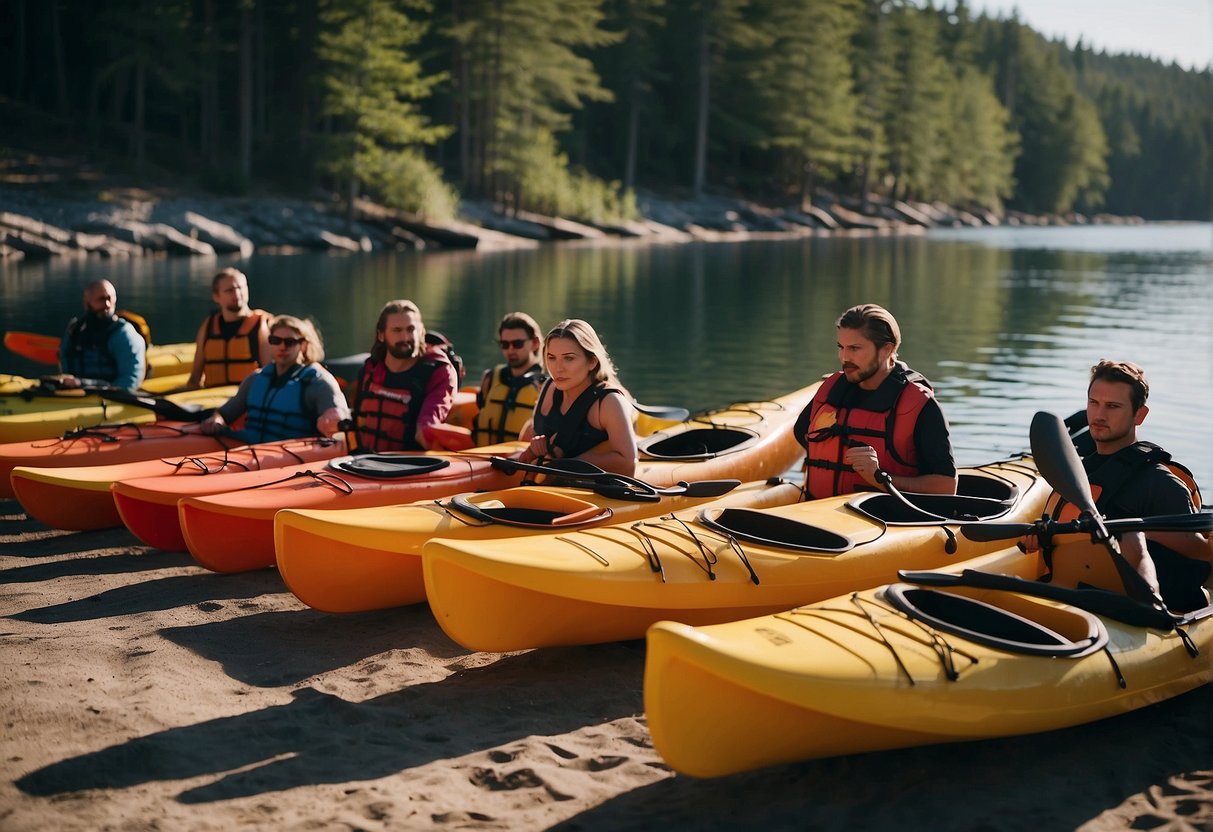
Route Selection
When planning a kayaking trip, it is essential to carefully consider your route. Factors to think about include the skill level of your group, the type of water you’ll be paddling in (e.g., open water or a calm lake), and the expected weather conditions.
To ensure the safety of everyone involved, consider the weakest paddler’s skill level when selecting a route. This will minimize the likelihood of accidents, such as flipping or being caught in challenging conditions. Keep in mind that visibility can greatly vary in different water bodies and changing weather, so choose a route with clear and visible conditions.
It’s also a good idea to research the area where you’ll be kayaking, paying special attention to potential hazards, available resources, and any Coast Guard or local authority recommendations.
Informing Others
Before setting off on your kayaking adventure, be sure to inform someone who is not part of the trip about your route, planned departure and return times, and group details. Doing so increases the likelihood of timely help in case of emergencies. To further enhance your safety, bring a communication device such as a VHF radio that doesn’t rely solely on cell reception. This will enable you to maintain contact with local authorities, like the Coast Guard, if necessary.
It’s also crucial to establish a clear and straightforward plan in case someone becomes separated from the group. Have an agreed-upon meeting point and time so that everyone can regroup, and assess any potential risks or communication needs.
When preparing for a kayaking trip, always prioritize the safety of all participants by selecting a suitable route and informing others about the trip’s details. By following these guidelines, you can ensure a fun and safe paddling experience for everyone involved.
Handling Emergencies and Rescues
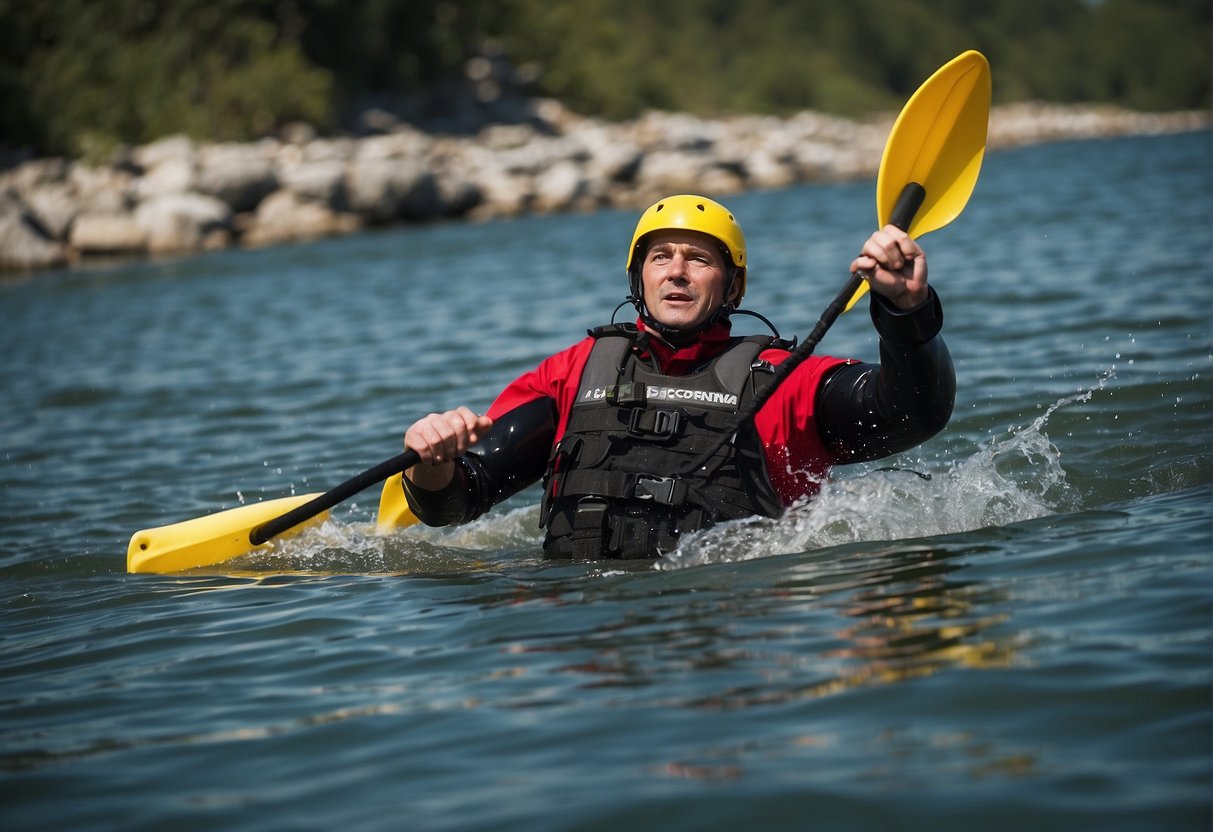
During kayaking, emergencies can arise, and it is essential to know how to handle them confidently and safely. This section covers self-rescue techniques and assisted rescue scenarios to ensure essential safety for kayakers.
Self-Rescue Techniques
- Wet Exit: A wet exit is a kayaking safety skill that involves getting out of a flipped kayak quickly and efficiently. It is an essential technique to learn and practice, especially for beginners. REI Expert Advice provides a series of articles on kayaking safety techniques, including tutorials on wet exits.
- Paddle Float Re-entry: If a kayaker needs to re-enter the kayak after a capsize, the paddle float re-entry method can be useful. According to Kayaking Nation, paddle float re-entry is a core self-rescue technique for kayakers. It involves using a paddle float and the kayak paddle to create a stabilizing outrigger to help the kayaker climb back into the kayak.
- Awareness of Cold Shock and Hypothermia: Sudden exposure to cold water can cause cold shock, which could lead to involuntary gasping and inhalation of water. Hypothermia is a more gradual issue caused by prolonged exposure to cold water, leading to a dangerous drop in body temperature. It is essential to wear appropriate gear, such as a wet or dry suit, to prevent hypothermia and be aware of the symptoms during cold water kayaking.
Assisted Rescue Scenarios
- T-Rescue: This technique is an assisted rescue method that involves the help of a fellow kayaker who comes alongside the capsized kayak, forming a T-shape. The American Canoe Association offers resources on flatwater kayaking safety, including the T-rescue method. The rescuer helps the person in the water to right the boat and stabilize it while the victim re-enters the kayak.
- Towing a Kayak: In certain situations, it might be necessary for one kayaker to tow another, either due to injury or fatigue. Kayakers should have proper equipment such as towlines or waist-belt towing systems to ensure a safe and efficient rescue.
- First Aid Knowledge: Injuries can happen while kayaking, and having first aid knowledge is crucial. It is essential for kayakers to carry a well-equipped first aid kit and know how to use its contents to treat common injuries such as cuts, sprains, or insect bites.
Keeping these self-rescue techniques and assisted rescue scenarios in mind will help kayakers maintain a safe and enjoyable experience on the water.
Special Considerations
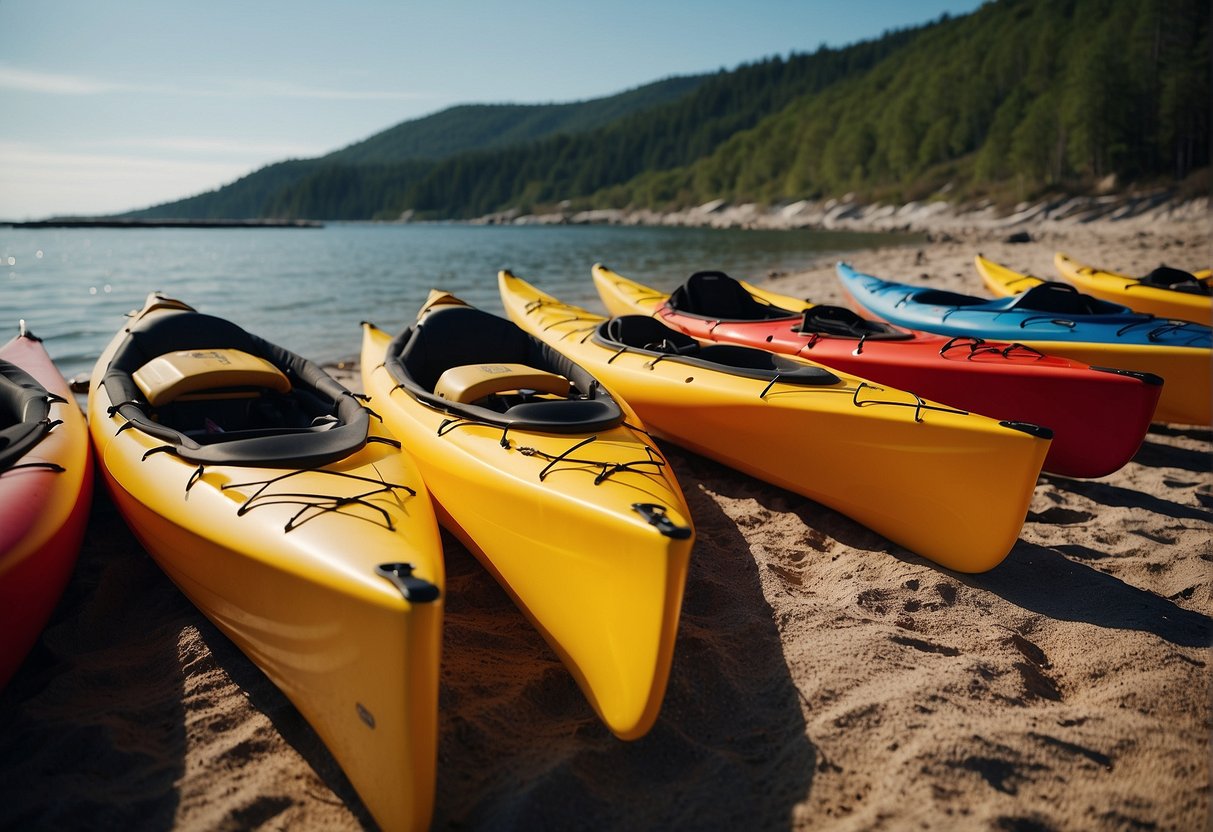
Coastal Kayaking
Coastal kayaking presents unique challenges due to factors like tides, currents, and the unpredictable nature of the ocean. Always wear a well-fitted Personal Flotation Devices (PFD) while kayaking along the coast. Be mindful that sit-on-top kayaks are more suitable for coastal kayaking since they are easier to maneuver in waves and are self-draining.
Here are some important tips for coastal kayaking:
- Familiarize yourself with local tides and currents to plan your route.
- Obtain an up-to-date weather forecast to avoid sudden storms or strong winds.
- Carry a spare paddle in case your primary paddle gets damaged or lost.
- Use appropriate kayaking gear like a wet or dry suit to protect against cold water and prolonged immersion.
Whitewater Kayaking
Whitewater kayaking is an exhilarating activity but involves greater risks due to the turbulent waters and potential obstacles. Acquiring proper training and experience is essential before you embark on this adventure. Make sure to always wear a PFD, helmet, and appropriate protective gear.
Here’s a quick list of whitewater safety tips:
- Equip yourself with a well-fitting whitewater kayak designed for the specific type of rapids you’ll be navigating.
- Ensure your kayak has appropriate buoyancy bags to minimize the risk of capsizing.
- Stay within your skill level and always go with a group, especially during your initial whitewater excursions.
- Practice essential techniques like the Eskimo roll, brace, and aggressive paddling in challenging situations.
In both coastal and whitewater kayaking, be well-prepared and prioritize safety. Following these guidelines will help ensure you have an enjoyable and safe kayaking experience.
Concluding Safety Strategies
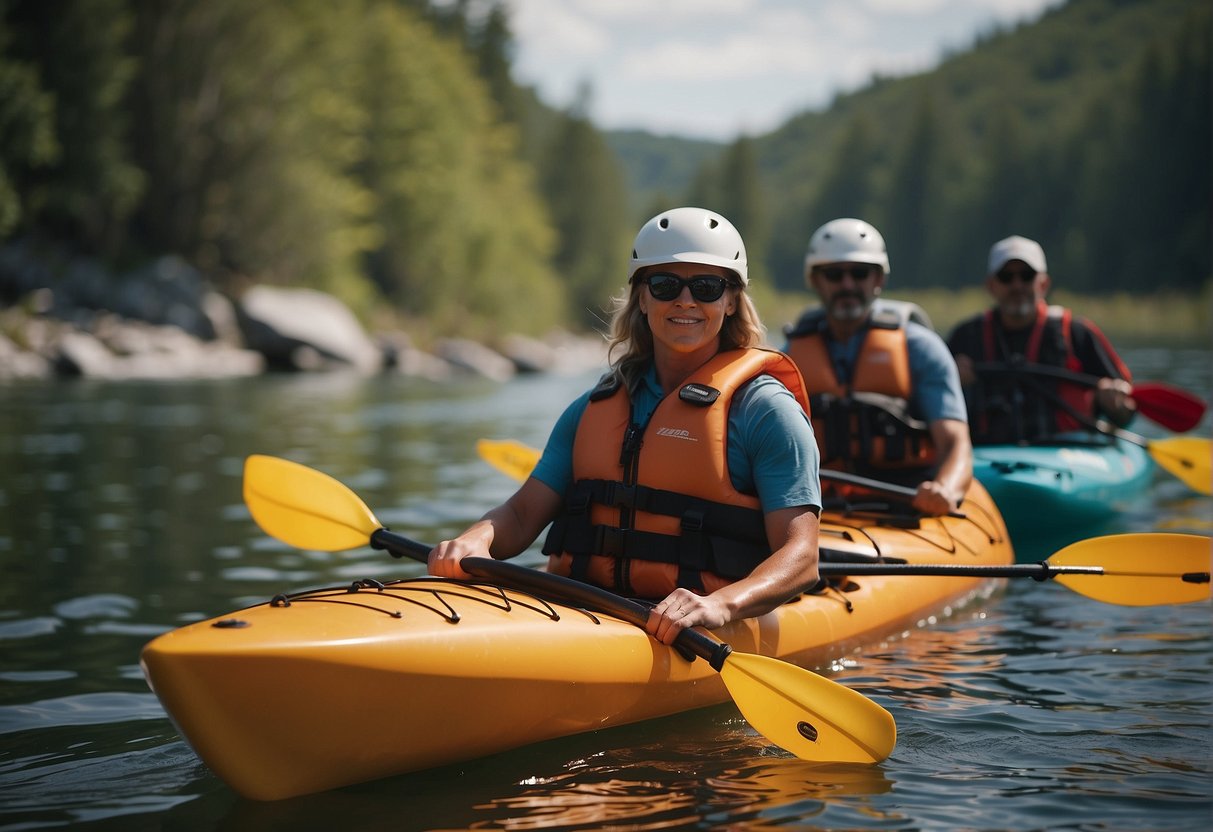
Continuous Learning
It is essential for kayakers to consistently improve their skills by engaging in continuous learning. One way to do this is by taking courses with reputable organizations like the American Canoe Association. Participating in such courses ensures the acquisition of practical skills and knowledge of best practices in kayaking safety. Additionally, kayakers should:
- Regularly practice self-rescue and assisted-rescue techniques.
- Attend workshops on first aid, CPR, and hypothermia prevention.
- Learn about the particular risks and challenges associated with the specific type of kayaking they enjoy, such as ocean kayaking or whitewater kayaking.
Staying Informed
To maintain a high level of safety while kayaking, it is crucial to stay informed about relevant safety measures and updates. Some ways to achieve this include:
- Monitoring their local weather forecasts for potential hazards and unfavourable conditions.
- Routinely inspecting and updating their kayaking equipment, such as life jackets, paddles, and communication devices.
- Consulting online resources on kayak safety, which contain safety checklists, and safety guidelines for their specific type of kayaking.
- Subscribing to newsletters or joining forums focused on kayak safety, outdoor recreation, and water sports to stay current on safety trends and recommendations.
- Networking with fellow kayakers and attending local paddling clubs to share experiences, safety tips, and updates on best practices.
By investing in continuous learning and staying informed, kayakers can ensure they are well-equipped to handle any challenges they may encounter and maintain optimal safety levels while enjoying the recreational and health benefits of kayaking.
Frequently Asked Questions
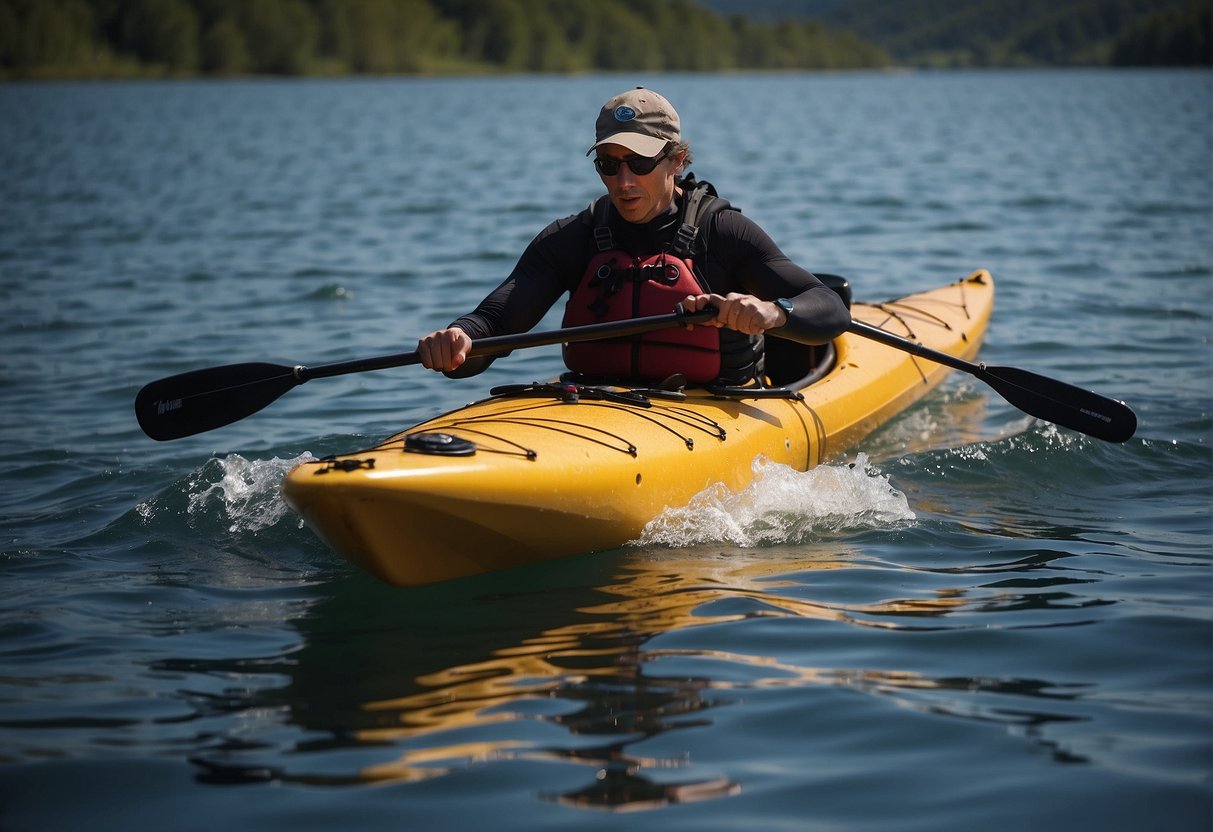
What essential items should one carry when going kayaking?
When kayaking, it is vital to bring essential items such as a life jacket, paddle, sun protection, drinking water, and snacks. Additionally, make sure to have a whistle, dry bag, extra layers of clothing, and a first-aid kit. It is also a good idea to carry a float plan, which includes information about your intended route, estimated time, and points of contact.
How can beginners ensure their safety while kayaking?
Beginners can ensure their safety by receiving proper kayak training, practicing basic paddle techniques, wearing a life jacket at all times, and knowing how to respond in case of an emergency. Staying within one’s skill level and planning a trip within one’s capabilities are also crucial for a safe kayaking experience.
What safety gear is mandatory when embarking on a kayaking trip?
Mandatory safety gear for kayaking includes a life jacket, paddle, and a whistle for signaling in case of emergencies. Additionally, it’s crucial to wear suitable clothing, including a wetsuit or drysuit if necessary. For optimal safety, consider bringing items such as a bilge pump, spray skirt, and navigation tools like a compass or GPS device.
Can non-swimmers participate in kayaking activities safely?
Non-swimmers can participate in kayaking activities, provided that they wear a properly fitted life jacket, stick to calm waters, and kayak with an experienced buddy. It is still recommended that non-swimmers consider taking swimming lessons to increase their confidence and safety while on the water.
What regulations should kayakers be aware of before venturing out?
Before kayaking, it is essential to be mindful of wildlife and the environment by familiarizing yourself with local boating and conservation regulations. These may include restrictions on access, speed limits, and the use of motorized vessels. Additionally, be aware of any permits required for specific waterways or activities.
What are common kayaking errors and how can they be avoided?
Common kayaking errors include poor paddling technique, not dressing appropriately for the water temperature, failing to check weather conditions, and not carrying essential safety gear. These errors can be avoided by taking a kayaking course, practicing basic paddle techniques, dressing for immersion, and always bringing suitable safety gear.
Conclusion

When it comes to kayaking, safety is paramount. By integrating key principles and practices into your routine, you can ensure enjoyable and secure kayaking experiences. This section highlights essential safety measures and tips to keep in mind.
First, invest in the appropriate gear to protect yourself from unforeseen circumstances. Items such as a lifejacket, helmet, and whistle are indispensable. Additionally, bring along a well-stocked safety kit that includes items like a first aid kit, paddle float, and repair tools.
It is also crucial to know your limits. Beginners should stick to calm waters, while those with more experience can gradually venture out to more challenging environments. Moreover, never shy away from seeking guidance or attending a kayaking safety course to improve your skills and response in various situations.
Developing an understanding of the weather and water conditions is equally important. Check the forecast before heading out, as sudden weather changes can pose considerable risks. Familiarize yourself with the currents, tides, and potential hazards in the body of water you intend to kayak.
Lastly, ensure that your kayak and equipment are in good condition. Regular checks and maintenance are vital to a smooth and safe kayaking experience. Do not disregard any signs of wear or damage, as these can escalate into bigger issues while in the water.
In summary, prioritizing safety while kayaking enables individuals to make the most out of this exhilarating sport. By following the guidelines outlined in this article, both novice and experienced kayakers can approach each adventure with confidence, knowledge, and peace of mind.



